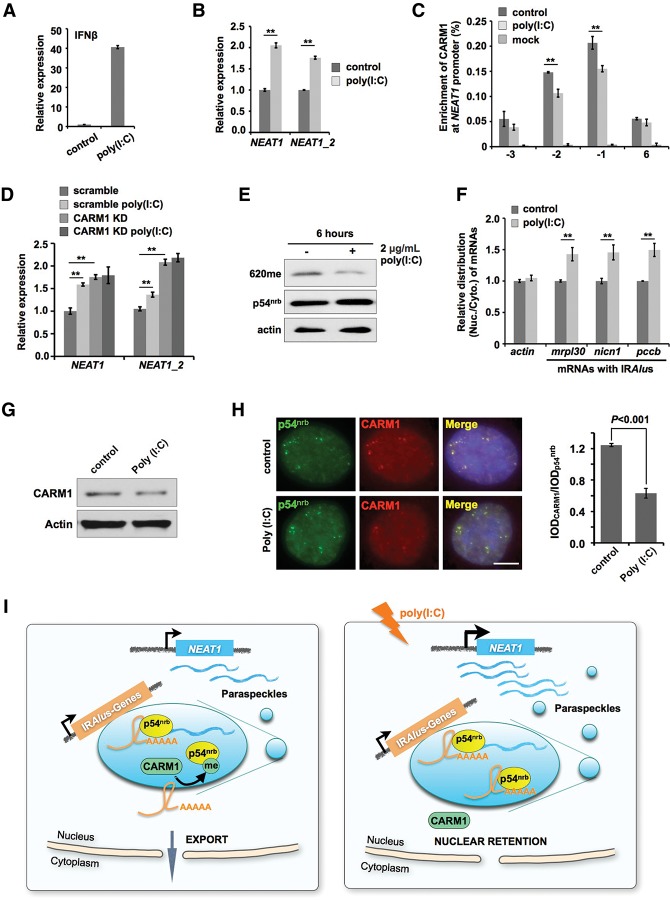Figure 7.
CARM1 is involved in the poly(I:C)-stimulated enhancement of nuclear retention. (A) Poly(I:C) treatment induces the expression of IFNβ. HeLa cells were transfected with 2 μg/mL poly(I:C) for 6 h and then harvested for analysis. (B) Poly(I:C) treatment induces NEAT1 expression. (C) Poly(I:C) treatment reduces the occupancy of CARM1 at the NEAT1 promoter. HeLa cells were transfected with poly(I:C) for 6 h and then harvested for CARM1 ChIP followed by qPCR. Data are presented as the percentage of CARM1 coprecipitating DNAs along the NEAT1 gene versus input under each indicated condition. (D) Poly(I:C) treatment induces NEAT1 expression in scramble-treated HeLa cells but not in CARM1 knockdown (KD) HeLa cells. (E) Poly(I:C) treatment reduces p54nrb methylation. HeLa cells were transfected with 2 μg/mL poly(I:C) for 6 h and then harvested for Western blotting analyses. (F) Poly(I:C) treatment enhances the nuclear retention of mRNAs containing IRAlus. HeLa cells were transfected with poly(I:C) for 6 h and then harvested for the nuclear and cytoplasmic fractionations. The relative subcellular distribution of transcripts of endogenous transcripts with IRAlus was investigated by RT-qPCR, normalized to the relative amount of actin mRNA in each fractionation, and compared with control HeLa cells. (G) The expression of CARM1 remains unchanged upon poly(I:C) treatment, as revealed by Western blotting. (H) The poly(I:C) treatment attenuates CARM1 localization to paraspeckles. (Left) Control and poly(I:C) transfected HeLa cells were stained with anti-p54nrb and anti-CARM1 antibodies, and representative images are shown. (Right) The statistics of p54nrb and CARM1 colocalization. The IODs (integrated optical densities) of punctuated anti-CARM1 and anti-p54nrb signals were measured by Image-Pro Plus from images taken with the same parameters (n > 100 double-positive staining cells). The ratio of IODCARM1 to IODp54 nrb was used to evaluate the extent of colocalization. The P-value from a one-tailed t-test in the pairwise comparison is shown. (I) A model of how the nuclear retention of IRAlus mRNAs at paraspeckles is regulated. (Left) Under normal conditions, CARM1 suppresses NEAT1 transcription and paraspeckle formation and also methylates p54nrb, resulting in the reduced ability to bind to mRNAs containing IRAlus. (Right) Upon appropriate stimulation, such as upon poly(I:C) treatment, actions of CARM1 are attenuated, resulting in an increased expression of NEAT1 RNA, unmethylated p54nrb, and enhanced nuclear retention of IRAlus mRNAs at paraspeckles. See the text for details. In B–D and F, error bars represent ±SD in triplicate experiments. (**) P < 0.01; n = 3.

